Identifying the Right Technologies to Get a Positive Return On Your Investment
- 5 ways communication and coordination technology can produce a positive ROI
- 7 technology investments aligned with patient needs
- 6 technology investments to increase your referral partner’s experience
- 5 technologies that can maximize home health value-based purchasing measures
- 9 ROI benefits that improve overall efficiencies
- 4 benefits that justify return on investment
Examining Current ROI Challenges
When it comes to healthcare technology, return on investment (ROI) benefits much more than your bottom line. It can improve quality of care, patient satisfaction, and more.
In this special report, we examine current challenges in home-based care and provide specific examples for determining a technology ROI.
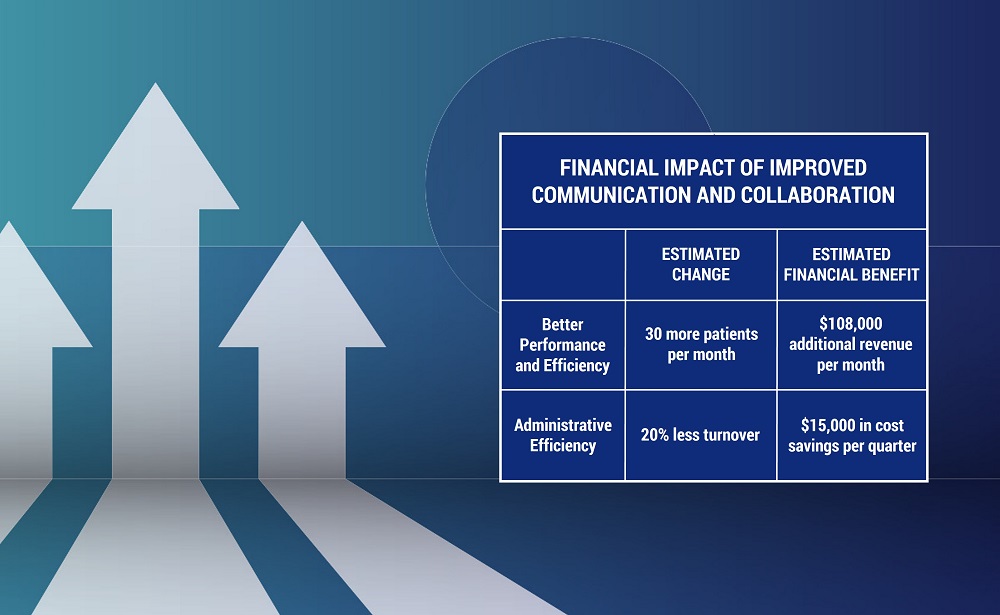
How Embracing Technology Can Produce a Financial Return
The home-based care landscape is expanding and changing. Moving forward, providers will be measured on performance related to patient outcomes, acute care utilization, and patient experiences. Tools that optimize efficiency, reduce the likelihood of human errors, increase patient satisfaction, and make staff more productive will be necessary to be competitive in this space.
Providers that can embrace the business case for technology may see the rewards – better outcomes and lower costs–reflected both in better patient care and a healthier bottom line. Investments in technology that supports communication and coordination are likely to produce a financial return for any organization.
5 Ways Communication and Coordination Technology Can Produce a Positive ROI
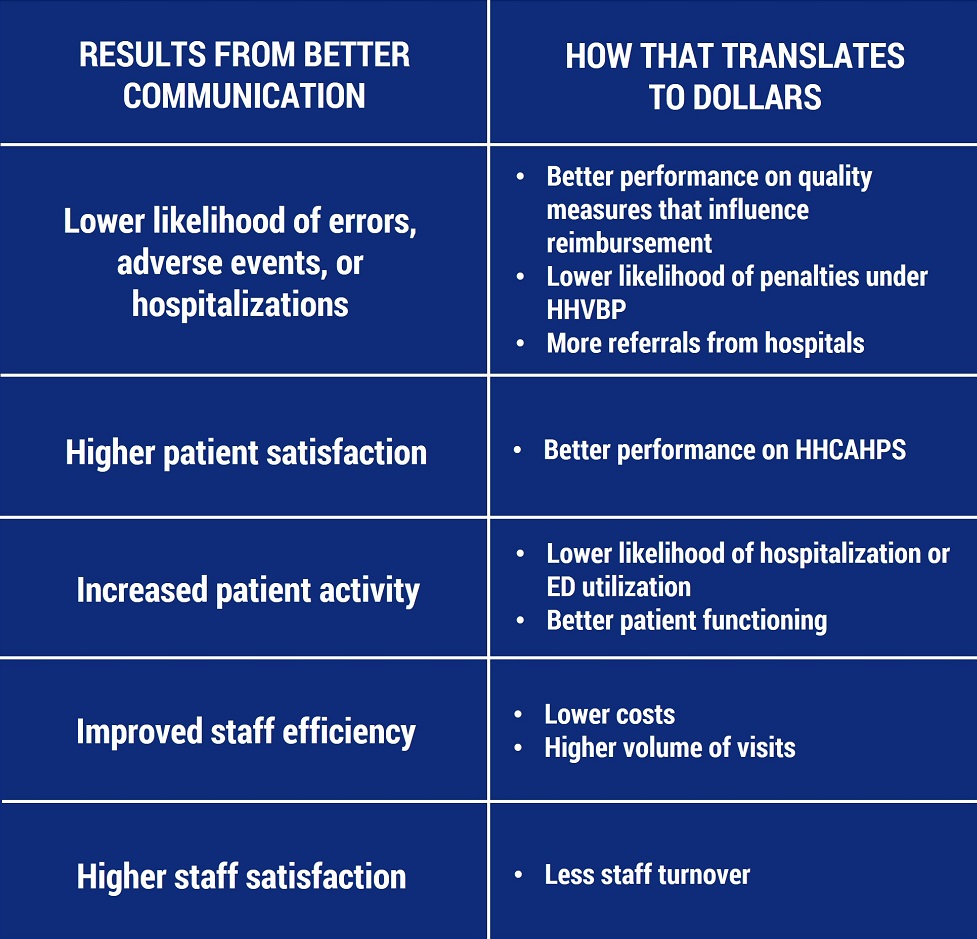
7 Technology Investments Aligned With Patient Needs
A new Porter Research study of 300 patients and family caregivers who experienced home healthcare in the last 12 months reveals that home healthcare providers are falling short when it comes to what really matters to the consumer.
What do Home Healthcare Consumers Say?
95% of respondents said that communication responsiveness influenced their satisfaction with the home healthcare provider.
Only about 40% of respondents reported being fully satisfied with their home healthcare provider when it comes to responsiveness on five communications-oriented categories on the HHCAHPS survey.
Respondents reported that using phone, email and insecure text messages was four to five times more likely to fail to produce an immediate response than a mobile phone app.
96% of respondents reported that they would choose a home healthcare provider that uses real-time communication technology via smart phone, tablet, or computer, and they would give that provider better HHCAHPS survey scores.
The results indicate that outdated communications mechanisms used most frequently by home healthcare providers can negatively impact the Home Health Care Consumer Assessment of Healthcare Providers and Systems (HHCAHPS) survey results and can heavily influence choice of home healthcare provider.
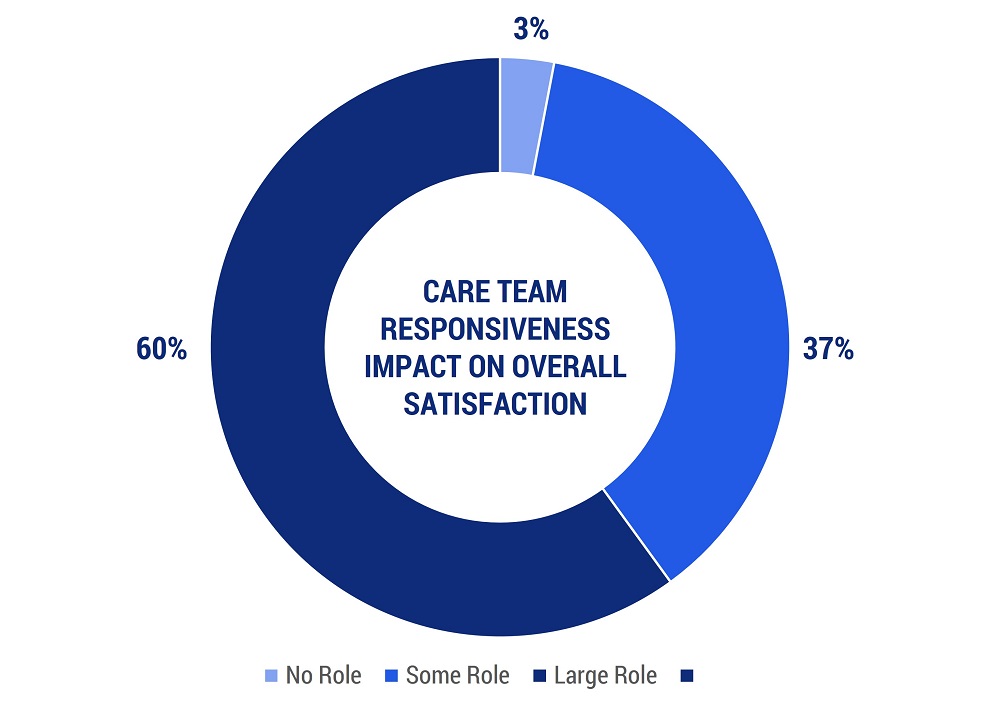
HHCAHPS Communications-Related Questions
The Porter Research study identified seven consumer priorities for communicating in real time through a smart phone, tablet, or computer. Providers should use this information to prioritize investments that can have the greatest impact on patients and family caregivers.
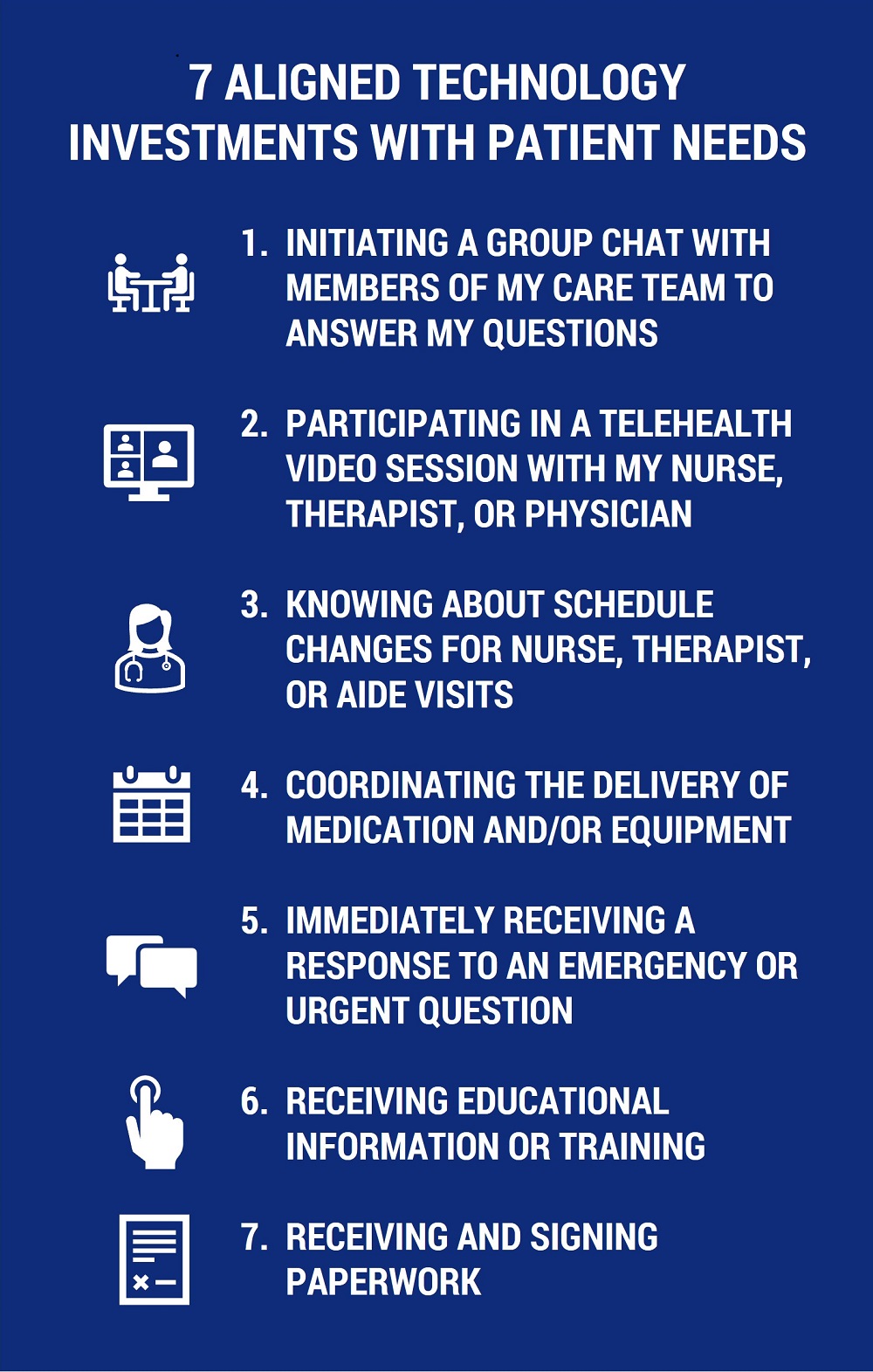
How Hospice Provider Communication Impacts Patient Satisfaction
New research reveals that most hospice providers are falling short when it comes to what really matters to those who make the ultimate decision on choice of provider and serve up hospice satisfaction scores – the hospice consumer.

What Influences Family Caregiver Satisfaction?
Across all methods of communication, over 90% of family caregivers indicated that the method of communication influenced their overall satisfaction scores. If family caregivers are not receiving immediate responses, are forced to play phone tag, and send several communications to make their loved one comfortable during one of the most stressful times in life, they will respond with low satisfaction scores.
6 Technology Investments to Increase Your Referral Partner’s Experience
Key frustrations among referring providers include unnecessary phone calls, lack of visibility into the patient care journey, delayed start of care, and reliance on fax.
Improving your technology tools can help you communicate seamlessly, see patients in a timely manner, and be more productive both in person and through virtual care – making you a more reliable home-based partner to your referral sources.
Up from 60% in 2019, 74% of referral sources say they would switch to a new home-based care provider if that organization was able to accept electronic referrals and interoperate with them effectively. With only half of post-acute care providers able to receive and use much of this critical data, serious frustrations between both sides of the referral equation are still very prominent.
How are Your Referral Source Expectations Shifting?
- Referral sources care more about interoperability than ever before.
- The pandemic has accelerated connected care trends.
- More app-based care is helping organizations succeed across multiple care settings.
- There’s a gap between what referral sources want and what organizations are prepared to deliver.
- Rehospitalizations need to be reduced.
6 Solutions to Respond to Your Referral Source’s Engagement
Having the ability to communicate seamlessly, capture and send data electronically, and streamline workflows creates a better experience for referral partners – giving you a competitive edge and fostering stronger, long-term relationships.
- Improved care coordination and collaboration.
- Faster patient onboarding.
- Enhanced remote clinical support and instant help.
- Increased patient confidence with access to education.
- Better clarity with visit scheduling and delivery coordination.
- More patient and caregiver satisfaction with streamlined communication.
Poor communication between nurses and physicians can be associated with an increased risk of hospital readmission among some patients.
For more details on improving referral engagement, read this e-book: 4 Greatest Challenges and How to Tackle Them with Technology.
5 Technologies That Can Maximize Home Health Value-Based Purchasing Measures
We’re on the verge of a new era of reimbursement, where your old methods of communicating could significantly impact your measurement outcomes. Quality measure performance and an increased focus on patient experiences require more streamlined communication, planning, and documentation of care.
The right technology investments ensure your organization maximizes its HHVBP measures – including Home Health Consumer Assessment of Healthcare Providers and Systems (HHCAHPS) scores, Outcome and Assessment Information Set (OASIS) assessments, and claims-based measures – and ultimately maximizes reimbursements.
Examples to Maximize HHVBP Measures
1. Start of Care: A key measure derived from data collected in the OASIS, timely initiation of care is the percentage of home health quality episodes in which the start of care or resumption of care date was within two days of the referral date or inpatient discharge date, whichever is later.
Solution: When your team is communicating effectively, they know when a patient is ready to start care. Technology such as secure text messaging helps you maintain HIPAA compliance and allows your care team to communicate instantly, share photos, and start a dialogue about the patient care plan. Customizable digital forms and app-less eSignature capture allow your team to expedite any needed signatures required to start care through digital document workflows.
2. Data from claims-based measures including Acute Care Hospitalization During the First 60 Days of Home Health Use and Emergency Department Use without Hospitalization During the First 60 Days of Home Health are used to calculate performance.
Solution: Providers can help patients and family caregivers use instant messaging to get routed within a matter of minutes to a nurse on call. No more phone calls going through an answering service, emails sitting in inboxes, or messages waiting for responses from the next shift. When nurses are available instantly, patients and caregivers know you’re there for them in an urgent situation.
3. In the HHCHAPS survey, patients are asked how well the home health team communicated with them throughout their care.
Solution: Multiple ways to communicate allows patients and caregivers to choose their preferred method of securely sending and receiving information. Secure instant messaging and video chat helps to maintain HIPAA compliance and gets patients answers from the care team faster than phone calls and emails. Making care teams easily and instantly accessible gives patients a sense of security knowing communication about their care is always at their fingertips.
4. In the Specific Care Issues section of the HHCAHPS survey, patients are asked whether the home health team discussed medicines, pain management, and home safety during their care.
Solutions: Technology can provide all training resources electronically and on-demand. Sharing is automated and it’s all accessible 24/7. This allows you to tailor materials for staff and those they serve.
5. To measure their overall perception of your organization, the HHCHAPS survey asks patients how they would rate the overall care from your organization and whether they would recommend it to friends and family.
Solution: The HHCAHPS survey gives patients a voice. Solutions such as customer-facing platforms include education materials, access to plan of care, and the history of the services offered. This helps patients remember the things you did for them and the high-level of care provided.
9 ROI Benefits to Improve Overall Efficiencies
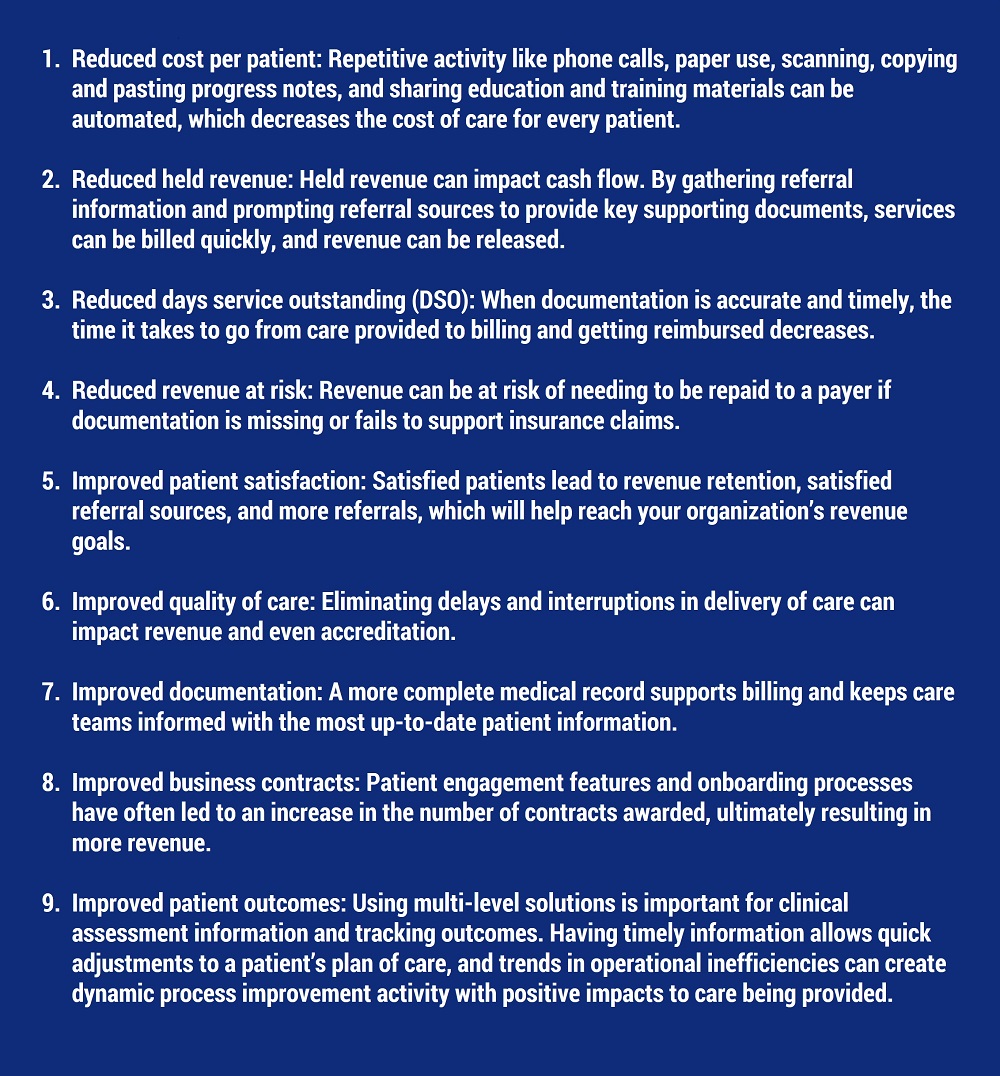
4 Benefits to Justify Return on Investment

When building a case for investing in technology, Melissa Kozak, RN, BSN, co-founder and president of CItusHealth, said home health providers should consider four benefits to justify return on investment.
1. Increased referrals and higher patient satisfaction. Studies show patients will give higher ratings on patient satisfaction surveys to organizations that facilitate more real-time communication, which in turn can lead to increased referrals.
2. Nurse retention and reduced staff turnover. Using new technology reduces stress on nursing staff and allows them to have a better work-life balance.
3. Creating more time for staff. By automating as much of the nonclinical administrative work as possible, staff will have more time to focus on clinical duties.
4. Improved patient outcomes. Employing modern technology will allow staff to stay in closer touch and collaborate more with patients, which can potentially reduce the likelihood of hospital readmissions.
“We need to embrace the collaborative approach and agree that clinician-to-clinician and department-to-department communication is critical,” Kozak said.
The Remington Report team is a talented pool of researchers, analysts, and knowledge seekers providing excellence in home care content.
Other Articles You Might Enjoy
Improving Outcomes Between Home Care and Medicare Advantage Plans
Home care services have emerged as a critical strategy for improving health outcomes, reducing hospital readmissions, addressing both clinical and non-clinical needs, and improved patient satisfaction among Medicare Advantage beneficiaries.
Average 30-Day Readmission Rates by Medical Conditions
We provide critical readmission data about average readmission rates, condition-specific readmission rates, and hospitals with high and low readmission rates.
Hospital-at-Home Readmissions: Which Medical Conditions Created the Highest and Lowest Readmissions?
CMS’s report on the Acute Hospital Care at Home (AHCAH) initiative highlighted the highest and lowest readmission rates by medical conditions.





